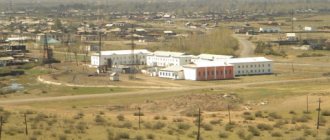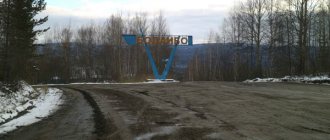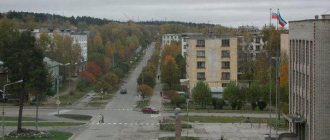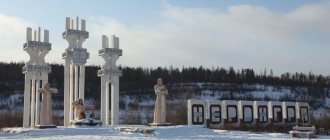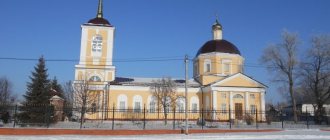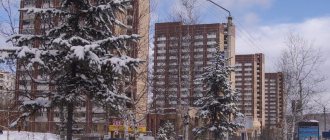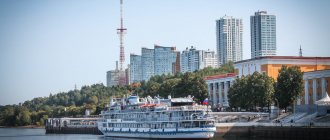City in Tuva, Russia
| Shagonar Shagonar | |
| City [1] | |
| Other transcription(s) | |
| • Tuvinian | Shagaan-Aryg |
| View of Shagonar | |
| Location of Shagonar | |
| Shagonar Location of Shagonar Show map of Russia Shagonar Shagonar (Republic of Tyva) Show map of the Republic of Tuva | |
| Coordinates: 51°33'N 92°46'E / 51.550°N Latitude 92.767°E / 51,550; 92.767 Coordinates: 51°33'N 92°46'E. / 51.550°N Latitude 92.767°E / 51,550; 92,767 | |
| A country | Russia |
| Federal subject | Tuva [1] |
| Administrative region | Ulug-Khem district [1] |
| City of district subordination | Shagonar [1] |
| Known since | 1888 |
| City status from | 1945 |
| Height | 560 m (1840 ft) |
| population size (2010 Census) [2] | |
| • General | 10 956 |
| • Evaluate (2018) [3] | 10 995 ( + 0,4% ) |
| Administrative status | |
| • Capital from | Ulug-Khem district [1], city of Shagonar of district subordination [1] |
| Municipal status | |
| • Municipal district | Ulug-Khem municipal district [4] |
| • Urban village | Shagonar urban settlement [4] |
| • Capital from | Ulug-Khem municipal district [4], urban settlement Shagonar [4] |
| Timezone | UTC+7 (MSK+4[5]) |
| Postal code [6] | 668210, 668218 |
| OKTMO ID | 93654101001 |
Population of Shagonar
| 2010 Census | 10 956 [2] |
| 2002 Census | 11 008 [7] |
| 1989 Census | 10 084 [8] |
| 1979 Census | 5 455 [9] |
Shagonar
(Russian: Shagonar; Tuvan: Shagaan-Aryg,
Shagaan-Aryg
) is a city and administrative center in Ulug-Khemsky District in the Republic of Tyva, Russia, located on the left bank of the Yenisei River, 124 km (77 mi) west of Kyzyl, the capital republics. At the 2010 census its population was 10,956. [2]
Links[edit]
Notes[edit]
- ^ abcdefgh Resolution #1648 ZP-1
- ^ abc Federal State Statistics Service (2011). “All-Russian Population Census 2010. Volume 1" [All-Russian Population Census 2010, vol. 1]. All-Russian Population Census 2010 [All-Russian Population Census 2010]
. Federal State Statistics Service. - "26. The size of the permanent population of the Russian Federation by municipalities as of January 1, 2022". Federal State Statistics Service. Retrieved January 23, 2022.
- ^ a b c d e Law No. 268 VH-1
- "On the Calculation of Time". Official Internet portal of legal information
. June 3, 2011. Retrieved January 19, 2022. - Post office. Information and computing center of OASU RPO. ( Post office
).
Search for postal service objects ( postal Search for objects
) (in Russian) - ↑
Federal State Statistics Service of Russia (May 21, 2004).
“The population of Russia, the constituent entities of the Russian Federation as part of federal districts, urban settlements, settlements, settlements of 3 thousand or more people” [Population of Russia, its federal districts, federal districts, districts, urban settlements, rural settlements - administrative centers and rural settlements with a population of more than 3,000 people] (XLS). All-Russian Population Census 2002
. - “All-Union Population Census of 1989. The current population of union and autonomous republics, autonomous regions and districts, territories, negative phenomena, urban settlements and villages. All-Union Population Census of 1979. National composition of the population by regions of Russia” [All-Union Population Census of 1979. Ethnic composition of the population by regions of Russia] (XLS). All-Union Population Census of 1979 [All-Union Population Census of 1979]
.
1979 - via Demoscope Weekly
(website of the Institute of Demography of the State University - Higher School of Economics.
Shagonar
(Tyva Republic)
OKATO code:
93254501
Founded:
1888
City since:
1945 City of district subordination (Ulug-Khemsky district of the Republic of Tyva)
Center:
Ulug-Khemsky district
Telephone code (reference phone)
| 39436***** | — |
Deviation from Moscow time, hours:
4
Geographic latitude:
51°32′
Geographic longitude:
92°55′
Altitude above sea level, meters:
560 Sunrise and sunset times in the city of Shagonar
Natural features
Khayyrakan is a huge depository of limestone ranging in color from black to white. Several times it was planned to build a high-tech cement plant at its foot, but each time the residents of Tuva opposed the construction. There is a unique structure near the mountain - an old lime kiln. Lime was extracted from the mountain, placed in a kiln and, through heat treatment for many days, an excellent building material was obtained.
There are many caves and grottoes on the western slopes of Mount Bear. The gentle slopes of the “Heavenly Bear” are overgrown with bushes and small flowers. In spring, when wild rosemary blooms, the slopes of Khayyrakan turn purple.
© Arthur Mongush
Tuvinskaya Pravda
This possibility, by the way, for some reason is still not being considered in the republic, focusing only on the construction of the railway. But back in 1984, work was carried out to identify the possibility of building an oil pier below the village of Khayyrakan. In those years, these plans were not implemented only because the volume of fuel and lubricants imported into Tuva was very small, which is why the estimated cost turned out to be high. In Novy Shagonar itself, on the banks of the Yenisei, a large river port was to appear, which would significantly increase its chances of creating a powerful industrial base in the city. While Ak-Dovurak and Khovu-Aksy were built as single-industry towns, where the only industrial enterprise became the city-forming one, New Shagonar had all the conditions for its development as a city with a diversified economy. Plants such as a cement plant were built here for the production of sand-lime bricks with a capacity of 50 million pieces per year; the possibility of building a chemical plant at the foot of Khayyrakan Mountain based on the processing of the Dus-Dag salt deposit and Khayyrakan limestone was considered. In addition, it was planned that several food industry enterprises would also be located in the new city, in particular, a brewery, a bakery, etc.
Therefore, the construction of New Shagonar was the most important task in the country; it was necessary to equip it in a short time in order to give a new impetus to the development of the entire republic. To increase the number of workers and reduce construction time, it was decided to attract student construction teams for the summer period, and young guys began to arrive in the republic from all over the USSR. Throughout the construction period, students from Moscow, Riga, Kyiv, Ufa, and other cities visited here in different years. One of these detachments, but not quite an ordinary one, worked from Novosibirsk. The fact is that in those years I studied at a party school there and told my classmates a lot about the grandiose construction project in my homeland. And we were all already adults, family men, and we all wanted to earn at least a little extra money during the holidays. So my classmates - Mikhail Sviridov from Altai, Gennady Komarov from Uzhur and Viktor Tushmakov from Kuragino, Krasnoyarsk Territory, Viktor Kuyukov from Khakassia, Alexey Lazebnykh and Alexander Vinogradov from the Irkutsk region, Alexander Shirokov from the city of Yurga, inspired by my stories, decided to participate in this construction and at the same time earn extra money. And, starting in 1974, having assembled a team of future party leaders, we began to go to the flood zone for construction. But, I must admit, our detachment did not have the easiest job: we manually - with shovels - dug trenches for laying the foundations of future buildings. And only then, two years later, the country’s Komsomol members continued our, so to speak, relay race.
Komsomol detachments made up of demobilized soldiers of the Soviet army were especially valued at the construction site. Since good organizers quickly emerged among them, they were immediately chosen as foremen, appointed as foremen, and superintendents. And then they grew to become leaders of other economic divisions of the republic, and not only of the republic, for those of them who, after completing their Komsomol mission, returned home, immediately received solid positions there.
The Tuvan regional committee of the Komsomol also created its own detachments, they decided to send volunteers from each district to the All-Union Komsomol construction site, and a headquarters was created to coordinate the work in the city under construction. Over the years, this headquarters was headed by young guys, mostly yesterday's schoolchildren. And their contribution was small: due to the lack of experience, there was also a large turnover in this position. But in those years when the headquarters was headed by Anatoly Ondar and Maria Damchai, the organizational skills of these Komsomol members had the most effective effect. In those years, the work of amateur artists revived, their own orchestra appeared, young people became so active in sports that there was a need to hold mass competitions among teams. This led to the fact that Builder's Day became not a day of mass celebrations, but a day of mass sporting events. These two leaders left a bright mark on the history of the All-Union Komsomol construction; young people appreciated their enthusiasm, optimistic attitude, ability to quickly and correctly find a solution, as well as their energetic commitment to the future and ability to infect others with it.
Each district of Tuva responded to the call of the Komsomol to send its volunteers, but the results of the work of these envoys ultimately turned out to be low. And there were, in my opinion, objective reasons for this. Having received allowances - money for the first time of residence - young people, especially from the western regions, could not withstand the rhythm of the new, urban life, the unusual loads and tests of a working person, especially in terms of labor discipline, because here they had no parental supervision. And the imaginary “freedom” sometimes led to disastrous consequences. And young people in this category fled without working at a construction site for even a few months. To a large extent, this was facilitated by the lack of organized leisure, when children from the districts did not have the opportunity to meet new friends or find a boyfriend or girlfriend. In a word, “Komsomol volunteers” from Tuva, and not only from Tuva, were consolidated; it didn’t matter in the first years of construction.
Sometimes there were even anecdotal cases. This already relates to the question of how the Komsomol activists of the districts related to the matter. Thus, thanks to the “zeal” of one of these district activists, but in reality a typical formalist, two original “Komsomol members” one day appeared in New Shagonar. They were about 40 years old, shabby in appearance, and in their hands were not only a suitcase, but also an accordion. The Komsomol apparatchik who delivered them handed over the “volunteers” to headquarters against signature and went home that same day. The owners of the new “working hands” so necessary for the construction, as expected, were accommodated in a dormitory. But in the morning they were no longer found there. As the temporary neighbors of the new arrivals, who were construction workers sent from Krasnoyarsk, said, a couple with an accordion, who immediately began to celebrate their arrival, after a few glasses, which loosened their tongues, began to complain. It turns out that they were simply kicked out of their families for drunkenness; moving, and especially working at a construction site, were not at all part of their plans. Therefore, no one was surprised when, after waiting for the morning dawn, the “volunteers” moved on foot towards Kyzyl. The district committee, taking advantage of the situation, thus carried out the order of the regional Komsomol committee and reported in numbers. The bureaucratic story had the following continuation: the quickness and ingenuity of this regional Komsomol leader were noticed, he was soon hired to work in the law enforcement agencies, from then on his career rapidly went up, and rose to the rank of colonel.
It should be noted that this case was the only one; the envoys of the Komsomol of Tuva were selected, basically, carefully, at the call of the soul, so to speak, and sought to settle in a new place in order to get a profession or find their destiny here. Another thing is that not everyone succeeded. But in general, if we talk about young people, the construction of New Shagonar and other settlements in the flood zone provided ample opportunity for the local population to find work and then acquire a profession.
This construction project also provided promising opportunities for those children who, having entered the university from Ulug-Khem, received a diploma, became young specialists, and could now return home, since their specialties had become in demand in their homeland. Here is a partial list of those who in their hometown had the opportunity to realize themselves after graduating from university: these are the Prudnikov brothers - Victor, Nikolai, Sergei; Vyacheslav Chepsarakov, Nikolai Pryakhin. Nikolai, for example, having worked in the Magadan region for three years after graduating from college, did not want to stay there and decided to take part in the construction of his city, and for a long time then headed the directorate of a cement plant under construction.
Over the years of working on the construction of New Shagonar, I had the opportunity to take part in the fate of many of its young builders. I remember a couple from Moscow - the Nikolaevs Vladimir and Nadezhda. Nadezhda was originally from Shagonar; one day, through her relatives, she turned to the construction management with a request for help in booking their living space in Moscow, since she and her husband wanted to come and participate in the construction of New Shagonar. The management of the Shagonartyazhstroy trust complied with the request. The young people worked in construction for three years, Vladimir worked as a mechanic at SMU, Nadezhda worked in the human resources department of the trust. They, like hundreds of other builders I have not mentioned, deserve a medal, if one is approved in honor of some of Shagonar’s next jubilee.
When talking about work in the flood zone, there is no way to ignore one of the piquant features of the construction of New Shagonar - the use of prison labor. Without this component, the construction completion time would have been much longer.
And they, these deadlines, were set by the government of the USSR for each object with a maximum value. Considering their condensation, the Ministry of Heavy Construction of the USSR, together with the Ministry of Internal Affairs, made an extraordinary decision - to involve parolees in the construction, which was popularly referred to by another term - “chemists”. In order for the labor of these “chemists” to be used in the flood zone, a separate infrastructure was needed. In particular, it was necessary to start with the creation of special commandant's offices. I.I. was appointed the first head of one of them - in New Shagonar. Bochkovsky, in the village of Chaa-Khol - A.G. Maksimov. The most direct connection with this contingent, who ensured that parolees went to work and that they observed discipline not only in the production area, but also in the residential area, was carried out by employees of the special commandant's office Valery Dongak and Alexander Glukhovchenko. The contingent of parolees was motley: thieves, murderers, rowdies... There were also escapes from the construction site, mainly “chemists” from the local population. Therefore, employees of the special commandant's office had to track down the places where the fugitives were hiding, and then return them to serve their sentences back in correctional colonies. To accommodate the special contingent, four dormitories were built in New Shagonar and two in Chaa Khol, with 150 beds each. And the total number of parolees who were involved in construction at different times sometimes reached 700 people. Naturally, the use of prison labor created new problems, hassles, and additional costs, but the advantages of attracting this additional force still outweighed.
Valery KONEV
(To be continued)
Religion
Since 2012, there has been an Orthodox parish in Shagonar in honor of St. Sergius of Radonezh. For its activities, the parish uses premises rented in the City Administration building. A missionary camp[17] has been operating on the basis of the parish since June 25, 2012, whose employees carry out educational work with both adults and children[18]. The Orthodox church and Orthodox community under construction in colony No. 4 are assigned to the parish[18]. Negotiations are underway with the kozhuun administration to provide land for the construction of an Orthodox church[19]
